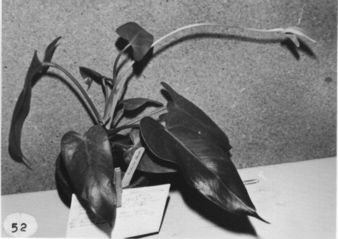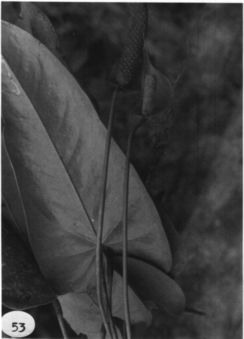





Anthurium cucullispathum Croat, sp. nov.
TYPE: Panama. Code: Alto Calvario, forest around Rivera sawmill, New Works, 7 or more km N of El Copé, 700-900 m, 8°40'N, 80-38-W. Folsom 3251 (MO 2603116, holotype; B. PMA, US, isotypes; Live at MO).
Planta epiphytica; cataphyllum membranaceum-subpersistens intactum; petiolus erectus et effusus, leres. (4-) 10-29 cm longus; lamina anguste ovata ad ovaio-triangulata, modice coriacea, basi cordata, 11-38 cm longa, 5-23 cm lata, pagina inferiore inconspicuc glan-duloso-punctata; inflorescentia effusa et nutans: pe-dunculus teres, 17-52 cm longus; spatha pallide viridc. subcoriacea, lanceolata ad late lanceolata, spa^:\ ;--cullatus, 5.5-14 cm longa, cremeus, 3-9 mm ior.g-s. baccae rubrae aurantiacae, 6-7 mm longae.
Epiphyte; stems thick, less than 10 cm long. 3.5 cm diam.; internodes short; leaf scars ca. 1.5 cm wide; roots green, smooth, descending- cataphylls thin, 8-12.5 cm long, acute at apex (apicu-lum subapical); drying dark brown to reddish brown (B & K Yellow 4/2.5), remaining intaci-subpersistent.
LEAVES with petioles erect-spreading, (4-) 10-29 cm long, terete; geniculum 0.5-2.5 cm long, scarcely thicker and paler than petiole; blades narrowly ovate to ovate-triangular, moderately thick,long-acuminate at apex (the acumen minutely inrolled) shallowly to deeply lobed at base, 11-38 cm long, 5-23 cm wide, broadest at point of petiole attachment:
anterior lobe 10.5-30 cm long, the margins straight to broadly convex; posterior lobes 2.5-8 cm from apex of sinus to outermost point; sinus parabolic to hippocrepiform, acute to rounded at apex; upper surface semiglossy, with sparse. conspicuous raphide cells, lower surface more or less glossy, with inconspicuous, round, gland-like punctae; midrib convexly raised to middle above. diminishing and sunken toward apex, convexly raised below; basal veins 3-5 pairs, first and second free to base, those remaining briefly coalesced, weakly sunken to flat above, flat to prominulous below; posterior ribs absent, the outer margin flat to weakly turned up; primary lateral veins 6÷15 per side, departing midrib at 45-55° angle, weakly sunken to flat above, flat to weakly raised below, more or less straight to collective vein, interprimary veins few, scarcely visible, flat; lesser veins visible on drying: collective vein arising from the first basal vein or one of the primary lateral veins 4-7 mm from the margin, loop-connecting the primary lateral veins, weakly sunken above, prominulous below.
INFLORESCENCE spreading, nodding, as long as or longer than leaves; peduncle terete, 17-52 cm long, up to 5 times longer than petioles; spathe subcoriaceous, pale green (B & K. Green 7/10), lanceolate to broadly lanceolate, held cupped over nodding spadix, 5.5-14 cm long, 2.5-3.5 cm wide, broadest at base to near middle, long-acuminate at apex (the acumen inrolled its entire length), rounded to truncate at base, inserted at 60° angle on peduncle; spadix creamy white, weakly tapered at both ends, 3-9 cm long, 7-9 mm diam. midway; flowers 4-lobed, 1.8-2 mm long, 2.2-2.4 mm wide, the sides jaggedly sigmoid, 7-8 flowers visible in the principal spiral, (10-) 12-14 flowers visible in the alternate spiral; tepals matte, minutely and densely papillate, lateral tepals 0.8-1.1 mm wide, the margins convex; pistils scarcely emergent, white; stigmas scarcely visible, elliptic; stamens emerging from the base, usually progressing to the third or fourth spiral before spathe fully opens, lateral stamens emerging first, quickly followed by alternates; anthers white, 5-6 mm long, 6-8 mm wide, held over pistil; thecae elliptic, not at all divaricate; pollen white.
INFRUCTESCENCE pendent; berries red-orange, paler at base, 6-7 mm long, 4-5 mm diam., mesocarp gelatinous; seeds 2, 3-3.2 mm long, 2.1-2.5 mm diam., 1.2-1.3 mm thick, enveloped in a sticky gelatinous envelope. Figs. 52 and 53.
Anthurium cucullispathum is known from Panama in Chiriquí, Veraguas, Code, Panama, and Darien Provinces at elevations as low as 350 m in Veraguas to as high as 1,500 m in Darien. It is found in tropical wet to lower montane rain forest life zones.
The species is a member of section Calomystrium and can be recognized by its narrowly ovate to ovate-triangular (more than two times longer than broad), moderately thick blade, its nodding inflorescence with a creamy white spadix, and by its pale green spathe that is held cupped over the spadix. It is also distinguished by usually having the stamens emerge promptly after the spathe opens or sometimes even before the spathe opens. The cucullate nature of the spathe gives the species its name.
Although Anthurium cucullispathum is vegetatively similar to several species in section Calomystrium, it is not confused with any others when flowering.
 |
 |
Map of Mesoamerican specimens with coordinates
Costa Rica Cartago: 1200-1400 m,, 1 July 1976, Croat 36725 (MO).
Costa Rica Cartago: 1400 m, 09.47.15N 083.33.15W, 14 June 1995, Herrera,
G. 7878 (CR).
Costa Rica Heredia: 700-950 m, 10.17.30N 84.04.30W, 10 April 1986,
Michael H. Grayum 6978 (MO).
Costa Rica Lim—n: 1000 m, 9.24.20N 83.05.35W, 10 Mar. 1992, Herrera
5282 (MO).
Costa Rica Puntarenas: R.B. Monteverde; Cord. de Tilarán, 15
m,, 6 September 1993, Erick Bello, E. Cruz, Roy & Leonel 5346 (CR).
Panama Bocas del Toro: 700 m, 8.45N 82.15W, 10 March 1985, T.B. Croat
& M.H. Grayum 60283 (MO).
Panama Bocas del Toro: 650-700 m, 08.45N 82.15W, 29 June 1987, Gordon
McPherson 11115 (MO).
Panama CoclŽ:, , Folsom 3251 (MO, SAR).
Panama CoclŽ: El Valle,, 6 Sept. 1991, Ingram 1111 (MO).
Panama CoclŽ: El Copé area, 800 m, 8.39N 80.36W, 31 Mar 1993, Thomas
B. Croat 75074 (CM, MO).
Panama CoclŽ: 700-900 m,, 18 May 1977, J.P. Folsom & R. Button
3251 (MO).
Panama CoclŽ:, 28 Feb. 1992, Ingram, S. 1383 (SEL).
Panama Darien: 70-270 m, 8.01N 77.44W, 08 October 1987, B. Hammel H.
Herrera & G. de Nevers 16112 (MO).
Panama San Blas: 50 m, 09.15N 78.15W, 3 noviembre 1991, Heraclio Herrera,
Johny Morris y Jimmy Mojica 1082 (MO).
Panama Veraguas: 570 m, 08.33N 81.08W, 13 July 1994, Thomas B. Croat
& Guanghua Zhu 76842 .
Map of South American Specimens with coordinates
Colombia Choco: 100-500 m, 06.15N 77.25W, 6 March 1983, Al Gentry &
Adrian Juncosa 41039 (MO).